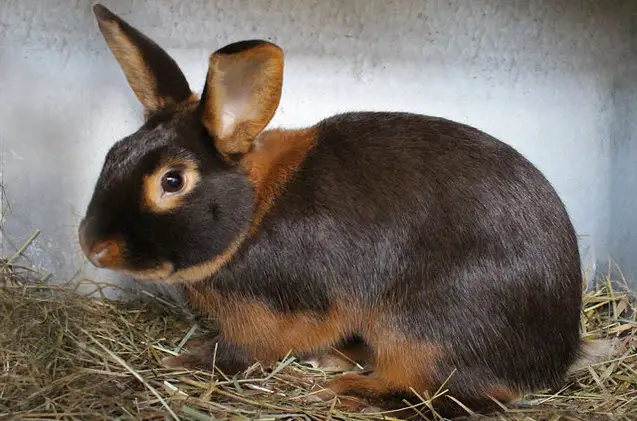Scientific Facts
| Common Name: | Tan Rabbit |
| Scientific Name: | Oryctolagus cuniculus |
| Life Span: | 8 to 10 years |
| Size (Adult): | Medium |
| Weight (Adult) | 4 to 6 pounds |
| Habitat: | Indoor human homes, breeding farms and pet shops |
| Body Shape: | United States |
| Country of Origin: |
Physical Description
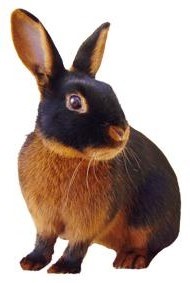
Tan rabbit breeds are one of the newest ARBA recognized rabbit breed. It has a lovely muscular body with a full-arched shape. This shape starts from the nape of the neck to the shoulders, midsection, and the hips. Tan rabbits are lean, with a well-balanced body, and have ears that stand erect.
This rabbit is known as a small to medium fancy breed of rabbit that was originally from England but has become very popular in the United States. An adult tan weighs from 4 to 6 pounds. In the United States, Tans have accepted weight ranges: does or females are 4 to 6 pounds while bucks or males are 4 to 5.5 pounds.
Tans are visually appealing because of their unique markings and contrasting color combinations. There are four varieties of Tans: black, blue, chocolate, and lilac colors. These have identical markings, but the tan color should be intense, deep red that should be prominent along the chest to the tail.
History of the Breed

The Tan rabbit was discovered in 1880 in England. This was when a colony of wild species bred with domesticated rabbits. Afterward, breeders started to develop, braising, and refining tan rabbits, and this has made the popularity of the Tan breed soar.
The black, blue, and lilac Tan rabbits were developed in the UK in the 1920s. Many years later, the breed was introduced in the United States. The first club made for Tan rabbits was the Tan Rabbit Specialty Club, which was recognized in 1960, but it was not until the 1990s when the Tan rabbit with a full-arched body become more popular.
After a while, the standards for the breed were overhauled. The Tan rabbit captured the Best in Show at the American Rabbit Breeder’s Association or the ARBA Convention held in 2003. This breed remains popular to this day, and many Tan lovers say that they are just getting started.
Fast Facts

The Tan rabbit breed is one of a few accepted rabbit breeds by the ARBA with a fully-arched body. When breeding a full-arched rabbit breed, this is known as the easiest to groom to become show-worthy. Every Tan baby produced will have the same color as its parents. All rabbits have a red-orange pattern on a dark coat, and the dark shading is found on the Tan rabbit’s head, back, and sides. Also, the tan markings are inside the ears, nostrils, around the eye, under the tail, chest, belly, and the nape of the neck.
Reproduction
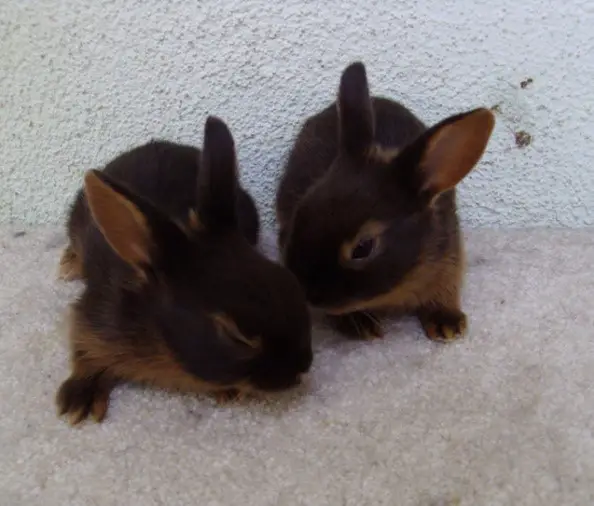
Tan rabbits reproduce like any other rabbits. Since this breed is a domesticated breed, it is forced to breed in captivity to get baby Tan rabbits. Rabbits can breed all year round and can start as early as 5 to 8 weeks old. First, the male is placed in his enclosure, and then after a few days, the female is added. Experts say that doing so can increase the chances of breeding and bearing offspring.
The female will initially remain still as the male sniffs her from head to tail, but occasionally, she will resist and will escape and run inside the cage. The male will try to catch her and then pin her. If she persists, for about an hour or so, remove her. Re-introduce her after another hour.
The female will soon submit to the male, and she will show this by lying down on her side and by allowing the male to sniff and mount her. The mating act is quickly over, and then you’ll know that it is successful when the male leaves the female alone. Remove the female from the cage and place her inside a separate cage where she can rest. The gestation period is usually 38 days long.
The female will look for a suitable area to build a nest, and this indicates that she will give birth soon. She will also refuse to eat and drink and may not be interested in socializing if kept in a communal enclosure. This is the best time to offer a birthing box. Fill this box with soft hay. The female may also use other materials nearby to line her nest and even her fur.
The female will soon give birth to three to five babies. Usually, a female can become pregnant three to four times a year. She will nurse her babies and clean them up, but she will soon leave her nest. The babies are born blind, deaf, and naked, very vulnerable to predators. The mother covers her nest before she leaves and will only come back every night to nurse them for only a few minutes. The little ones will open their eyes from 5 to 7 days and then wean from their mother from 10 to 12 days.
Personality and Behavior
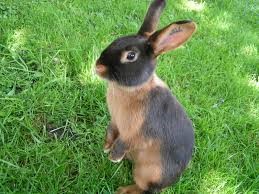
The Tan rabbit is known for its friendly, sweet, and energetic nature. It is also an intelligent breed as it can learn tricks easily. It is a very smart breed and can learn using tricks, food, and treats.
And because of its very energetic nature, it may not be suitable for young children and seniors. It is best for an experienced owner who is looking for an active rabbit.
An owner can teach rabbits simple tricks like playing ball or to come when called. Rabbits also enjoy playing on their own and may sometimes be contented with chewing on things as they sit alone in a corner. But nonetheless, all rabbit breeds are social animals, and they will love to mingle with other rabbits of the same kind.
Comparable Breeds
The lovely Tan rabbit is comparable with two impressive breeds, as well: the Harlequin rabbit and the Thrianta rabbit. The Harlequin is very similar to the Tan because of its pattered color markings. However, the Harlequin can grow to a large rabbit that weighs from 6.5 to 9.5 pounds and has a commercial body shape. This rabbit is a curious, active, playful, and affectionate breed and thus perfect for families, singles, and for people who live in a small space like an apartment.
The Thrianta rabbit is similar to the Tan rabbit because of its lovely color and its agile, muscular body. The Thrianta is a medium-sized rabbit that weighs less than 6 pounds and can live up to 8 years. It has a compact shape and is a docile, curious, but gentle rabbit. It is a rabbit breed recommended for seniors, people who live in apartments, and for single individuals.
Care of Tan Rabbits
Consider yourself lucky if you’re taking care of a Tan Rabbit. This is a unique rabbit breed, is friendly, calm, and is known to be one of the easiest to take care of. Caring for this breed is like caring for other rabbit breeds. You must make sure that your pet has the right diet, housing or enclosure, proper medical treatment, and lives with at least two or three rabbits.
An important part of a rabbit’s daily diet is hay. This is the bulk of a rabbit’s diet aside from rabbit pellets, which are commercially-prepared food that has vitamins and minerals for your rabbit’s good health. Add vegetables and fruits to their meals for a healthy, well-rounded rabbit diet.
Place unlimited fresh water and hay because this is an important part of a rabbit’s diet because it’s rough and can help keep their digestive tracts regular. An inverted water bottle with a spout at the end is also a good spill-proof way to drink.
Make sure that your pet is eating the right food. Avoid food such as produce with pesticides, toxins, and herbicides by feeding it organic fruits and vegetables. Younger rabbits need alfalfa hay because it’s rich in calcium needed for growing bones. Meanwhile, adult Tan rabbits will eat legume hay.
Captive-bred Tan Rabbits can become calm and friendly pets, but you must invest time and effort to train them well. One way to do it is to constantly interact with your pet rabbit. Also, rabbits are social animals and thus will need companions aside from playing with their owners. Rabbits that grow up having constant companions and regular interactions with their owners are healthier, happier, and well-rounded individuals.
Tan Rabbits are meticulous groomers and will groom themselves to the point that it can take hours before it’s over. Rabbits also groom each other and experts to say that this a way to bond with other rabbits. You may also notice mother rabbits grooming her kits when she is still in her nest, but this won’t last as she will leave the nest as soon as she delivers. She will return to the nest in the evening only to nurse her babies for a short while.
Tan Rabbits are mostly active in the daytime and sleep in the evenings. Therefore, feeding your pet, Tan Rabbit should be done in the morning when they are active. Captive rabbits can sleep 8 hours a day and may sleep closely together to keep themselves warm.
Supplies and Cages
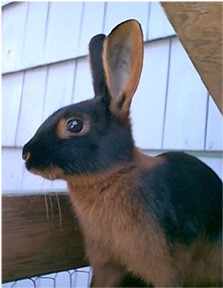
Tan Rabbits are very energetic, and therefore, it requires a big enclosure where it can play, sleep, interact, and run. This cage should be made of wire and a very strong frame. The bottom of the cage should be removable, and this is where the rabbit’s droppings will fall. This pan is easy to remove and makes it easier to dispose of the poop as well. The floor of the enclosure should have soft bedding and lined with good quality cage bedding.
Install a rabbit hay feeder on the side of the enclosure. Fill this with hay so your rabbit can eat when it is hungry or when it’s boring. For the bedding, use hay, wood pellets, or horse bedding.
To clean the cage, remove your pets and place these in a safe and clean container, box, or cage. Use only a safe cleaner or cleaning product like white vinegar, baking soda, or lemon juice. Never use household cleaners because these may have dangerous ingredients that can negatively affect your pet’s health.
Have a separate or extra cage if you want to take care of baby Tan Rabbits. Baby rabbits are born naked, deaf, and blind. These should have a warm enclosure to keep their bodies at the best temperatures. A smaller cage with cage lamp or lighting will suffice to keep kits dry, warm, and safe from predators.
And just like other breeds, Tan rabbits will love chewing on anything it can lay its eyes on. If these rabbits are kept indoors, these will chew on anything made of wood and other light materials, and what’s worse, it can also chew on electrical wiring. To avoid accidents, provide hay or chew toys in the cage. You must rabbit-proof your home before releasing your pet from its cage.
Health Concerns
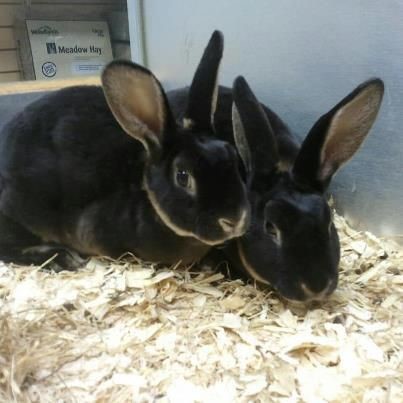
A Tan Rabbit is a healthy breed, and these are not affected by any specific disease. The reason for this is extensive breeding as a show rabbit. The most common condition that the Tan may be affected with is common pests such as mites, ticks, and fleas. These are naturally found in their environment.
Meanwhile, Tan rabbits are not immune to common rabbit diseases. This is why you must always monitor your rabbit’s health and temperament. Any kind of change could be due to an illness. As early as your pet opens its eyes and get out of its nest, take it to the vet for vaccinations and tests.
The vet will recommend tests to assess the overall health and development of your pet. Also, small and younger rabbits have sensitive digestive systems and, therefore, could be prone to enteritis, bloat, and stasis. These conditions may affect rabbits that are less than two months of age.
Also, take note of ear or fur parasites, and the most common are mites, fleas, and ticks. Rabbits that have these parasites usually have poor hygiene and are housed in dirty surroundings or enclosures.
Check your rabbit for any signs of illness like poor appetite, nasal and eye discharges, constipation, diarrhea, and vomiting. Check for an unsteady gait, restlessness, teeth grating, and sleeping for extended periods because these could be a serious condition.
Another very important part of caring for rabbits and other pets is deworming. Your Tan must be treated for worms at least once a year and must be done during springtime and fall. Don’t forget deworming because this is a major concern especially with rabbits that are from the wild or wild parents
All rabbit breeds should be dewormed at once. Use a pea-sized deworming paste will do. Put this in the rabbit’s mouth, and this will lick and swallow the medication till it’s gone. You should follow the dose according to your vet’s advice.
Dental Care
A rabbit’s teeth will grow continuously, and sometimes, their teeth can grow to extreme lengths that it can pierce their mouth and gums, causing pain and discomfort. As an owner, make sure that the rabbit’s teeth don’t overgrow to avoid causing a lot of stress. Help your rabbit by offering hay because this can grind the rabbit’s teeth naturally as it chews. You may also pieces of wood, wooden baskets, or other toys and accessories to fill the rabbit’s teeth. Monitor your rabbit’s dental health to save on expensive medical and dental bills.
Spaying or Neutering
Rabbits are very promiscuous, and therefore, you must control this by spaying or neutering your pets. Spaying and neutering should be done at a young age. However, some vets prefer to wait until the rabbits are six months old. Tan bucks are also neutered at a young age because experts say that neutering reduces aggression. Some vets neuter bucks at three months, which might be too early, considering that this male rabbit may not be ready to mate yet. For any question about spaying and neutering, talk to your vet at once.
Grooming

Tan Rabbits have short furs, depending on the color of the coat. But no matter what coat your rabbit has, it will need regular grooming. Use a sturdy brush to keep the fur clean, shiny, and free from common pests. Groom this with a small brush at least once or twice a week.
Grooming must also be done more frequently during their molting period, which is a time when the rabbit loses its old fur to make room for new fur. And to prevent wool blocks and to keep the rabbit from ingesting their fur, you can help by grooming your pet.
If your rabbit is very dirty, never bath it because this can cause stress. Instead, use a damp towel to spot clean the dirt. Simply wipe the rabbit down with the towel and use a dry one to finish off. You now have a clean, newly ‘’bathed’’ rabbit! Don’t forget to trim your rabbit’s nails monthly and check its mouth for overgrown teeth.
Availability – Where to Get One
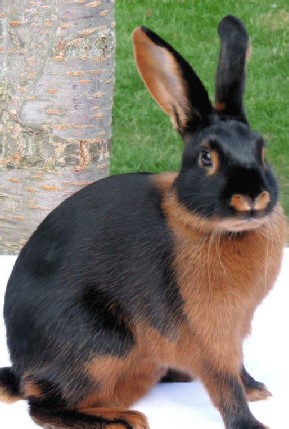
A Tan Rabbit may be purchased from a breeder or a retailer. The price will vary whether you are getting a rabbit as a pet or for show. You can expect the price to change depending on gender, size, coat quality, color, and appearance.
If you are searching for a reliable breeder, look for one that breeds healthy Tan rabbits with no genetic disorder. Purchase your Tan rabbits from reliable breeders. You can also follow this breed in local trade fairs and farm events. There are also ARBA shows that highlight this special breed.
How to Care for a Tan Rabbit
This is a summary of how to care for a Tan Rabbit breed. Caring for a Tan is just like caring for other rabbits. Remember the four basic components of rabbit care: a correct diet, housing, companionship, and medical care.
When it comes to the rabbit’s correct diet, the main food of captive-bred rabbits is hay. Hay is important in their diet to grind their every-growing teeth, keep their digestive system healthy, and maintain regular bowel movements. Another good food is a rabbit pellet with added nutrients, vegetables, and fruits for a well-rounded diet. You may also give them food in their natural habitats such as grasses, twigs, birch, and weeds, to name a few.
No matter what happens to keep water and hay inside the rabbit’s cage. You must place water in a large, heavy, and shallow dish so that your rabbit can drink from it right away without spilling.
Captive-bred rabbits like the Tan can only become a calm, friendly, and docile pet when you take time to train and bond with it. You must train and interact with your pet daily. Captive rabbits are also social animals and will need a rabbit companion or, better yet, some companions.
If you don’t have the time, space, and resources to care for two or more rabbits, then you might be better off with another pet. Take note that your rabbit can grow healthy and develop a good temperament with a docile behavior when it socializes with you and his companions.
Don’t forget to take your pet to the vet early on because it needs vaccinations, tests and should be given a clean bill of health before it is allowed to remain with other rabbits, pets, and people. You must understand the different signs of illness in rabbits as well.
FAQs
What do Tan Rabbits eat?
Tan Rabbits are herbivorous, and it will eat plants. These will eat all parts of the plant, such as roots, bark, seeds, weeds, flowers, and leaves. In captivity, it can eat commercially-prepared rabbit food, vegetables, seeds, nuts, and fruits.
Should you rescue a wild rabbit from the forest?
Don’t pick a wild animal such as a rabbit from the forest. You won’t be able to tame it, and you make it your pet because it will remain wild. So, if you see an injured rabbit, you may call animal services for help.
Are Tan Rabbits endangered?
No, Tan Rabbits are not endangered. Tan rabbits are domesticated rabbits and hence are available from local and international breeders as well as in pet shops and of course, in human homes as pets.
Can Tan Rabbits swim?
Yes, Tan Rabbits can swim like other rabbit breeds but won’t swim as good as other water animals. But most rabbits do not want to get wet and will not like a bath since this is stressful to them.
How do you tame a rabbit?
A wild rabbit cannot be tamed because you might end up getting bitten and hurt. You may otherwise train a captive-bred rabbit instead because most of these rabbits have a docile behavior and are friendlier than wild rabbits.
Will Tan Rabbits eat fruits and vegetables?
Yes, Tan Rabbits will eat fruits and vegetables, and aside from these, you may also feed your Tan Rabbits commercially-prepared pellets or rabbit food, which contain nutrients for your pet’s good health.
Will Tan Rabbits eat their droppings?
Yes, just like all rabbit breeds, the Tan Rabbit will eat its poop because these still have nutrients in them. But after eating this once, they won’t do it the second time. No one knows why rabbits do this, and you can prevent this by removing their droppings as soon as you see them.
Can you keep a Tan Rabbit as your pet?
You can keep Tan Rabbit as a pet because it is docile and sweet. This is a good pet for families and also for families with children, but space is very important since Tan rabbits are very active.
Are Tan Rabbits carnivorous animals?
No, these rabbits are not carnivorous and are herbivores, which means that these won’t eat meat. This rabbit will consume plants or plant parts like roots, bark, leaves, flowers, twigs, stems, seeds, and many more.
Can you keep two or more Tan Rabbits inside one cage?
You can keep two or more rabbits in one cage as long as you have a large cage to keep your pets in. The cage should be large, comfortable, and safe so that your rabbit or rabbits can remain safe and comfortable in their cages.
How do you clean a Tan Rabbit’s cage?
To start, remove the rabbit inside the cage and place it in a clean cage. Remove the pan under the cage and dispose of the droppings carefully. Hose the cage down and use a brush and cleaning product and clean the cage walls, bottom, accessories, and toys. Change the cage bedding and make sure that everything is dry before putting your pet back inside its cage.
Where do Tan Rabbits live?
Tan Rabbits are not found in the wild because these are domesticated rabbits. Tan rabbits live in human areas and commercial areas such as breeding kennels, pet stores, and also in human homes as pets. For Tan rabbit pets, these may be housed in large indoor or outdoor cages, preferably in groups for companionship.
How do you take care of baby Tan Rabbits?
If you want to take care of baby Tan Rabbits, put the kits in a comfortable and warm cage. Feed baby rabbits soft pureed food, and keep these safe and warm. Protect from predators nearby like your house cat or pet dog. For wild-caught rabbits, don’t move them and just call animal services to have these rescued.
Can you leave Tan Rabbits indoors or in your home?
You may let a rabbit stay indoors but only under your constant supervision. You must use a portable fence to keep it off areas that you don’t want it to can’t go. Also, you must rabbit-proof your home before allowing your pets out of their cage.
Are Tan Rabbits territorial?
Breeders say that Tan Rabbits are also like other rabbits in such a way that these may become territorial when these are kept in a small enclosure. Males can develop aggressive behavior and may become very dangerous to other males, especially during the breeding season. The aggressive males can bite, scratch, and kick other males in the cage to fight for hierarchy.
Do you need to use a heater inside a Tan Rabbit’s cage?
You may use a cage lamp to provide heat. But in cold climates, you must use a small portable heater and place this near the cage to create a warm and comfortable place for your pet and also for incubating kits.
Will a mother, Tan Rabbit, eat her young?
There are rabbit species that can eat their young. And if you spot a female Tan Rabbit eating her young, remove it from the litter or nest and don’t allow it to breed anymore.
Where do you place a Tan Rabbit’s cage indoors or outdoors?
Indoors or outdoors may depend on your preference. You may place the cage indoors to protect it from the sun, rain, and the cold, but your pet will have a limited space to play and may not be enough to house a large, adult Tan Rabbit. When you place your cage outdoors, the rabbits may need to deal with the elements, but at least they will have a large area to move about.
Does it hurt when a Tan Rabbit scratches you with its hind legs?
Yes, because Tan Rabbits have sharp claws, especially on its hind feet. This rabbit can kick hard with its hind feet, which can inflict damage. Tan rabbits will only do this when it feels threatened or afraid, so if you handle it well, then it won’t hit scratch you.
How large should a Tan Rabbit’s cage be?
One Tan Rabbit must be placed in a very large enclosure because of its size. For two large Tans, double this area. You must never overlook the cage size and always make sure that your rabbits have space to play, eat, and sleep, and you consider the number of rabbits inside the enclosure.
Are Tan Rabbits bites fatal to humans?
Yes, Tan Rabbit bites are dangerous because the species may have rabies. Also, rabbit teeth may be huge, and this can easily tear off skin and flesh and can lead to a deep and infected wound.
Can Tan Rabbits escape their enclosures?
Yes, Tan Rabbits can escape their cages by kicking their cages down. These can also jump over and escape, but will also use force if necessary to escape.
Can you prevent a Tan Rabbit from eating his droppings?
You can stop a Tan rabbit from eating his poop by removing the droppings after these defecate, but of course, you can’t watch your pets all day just to check if it has pooped! And no matter what, these animals will still eat their dropping because they know it still has nutrients.
What happens when the teeth of a rabbit grow longer?
When the teeth of the rabbit become longer, these can pierce its mouth and gums, and this can cause a lot of pain and may also affect its appetite. This is why you must take your rabbit to the vet and dentist regularly. You can also help it by feeding it hay since this can grind their teeth short as the animal chews.
How often does your pet should visit the vet?
Rabbits must visit the vet at least twice a year. Young rabbits must also be vaccinated against diseases as early as possible, and they should have an initial visit to a vet during when they are just a few days or weeks old.
Can rabbit diseases affect humans?
Some rabbit diseases affect only rabbits, while some are dangerous to humans. And if your rabbit is sick, take it to the vet as soon as you can. You must understand the different signs of illnesses such as poor appetite, loose stools, constipation, sneezing, problems with breathing, and changes in behavior. Take your pet to the vet as soon as you notice any of these.
Do Tan Rabbits have good hearing?
The Tan Rabbit has good hearing. It can hear its predators from far away, and this gives it time to jump and escape the threat.
Can rabbits see well while in the dark?
Yes, rabbits have good vision at night. This is why some species prefer to forage for food at night. Rabbits such as the Tan Rabbit also have good smell and hearing, which again allows them to look for predators near their area.
Can you train your rabbit to walk with a collar and leash?
Some pet owners are successful in training their pet rabbits to wear a collar and a leash, but some say that this may depend on what breed of rabbit you are training.
Will Tan Rabbits recognize their owners?
Some rabbit owners say that their pets can recognize them and can tell if they are being handled by their owners or by a stranger or by someone else.
Can rabbits survive the cold climate?
Yes, rabbits can stay in the cold and survive by looking for food that’s under the blanket of snow. Rabbits will use their legs to dig out snow and eat roots, shrubs, berries, and other unfrozen food.
Can Tan Rabbits remain outdoors?
A pet Tan Rabbit may be allowed to stay outdoors, but you must rabbit-proof your yard or outdoor area first. A portable perimeter fencing is a safe way to limit the area where the rabbit can stay free. Bury the fence poles to prevent the rabbit from digging the post out and then escaping.
Where do rabbits sleep in the wild?
In the wild, rabbits can sleep in holes or burrows. Rabbits can dig deep holes as deep as several inches to remain inside all day. Rabbits can sleep in their dens and nests. In captivity, they are forced to live in an enclosure that can accommodate a group of rabbits. This enclosure is safe and secure from predators.
Can pet rabbits be patient with young children?
Some rabbits don’t want to be held, especially by young children, and some are calm, docile, and friendly and will be okay when held and petted by young children.
Will your pet rabbit survive the cold?
Some pet rabbits can survive the cold and will find it fun to play in the snow. Some rabbits can change their fur color to adapt to the winter climate while some may not survive the cold like desert rabbits breeds.
Can you place the cage of Tan Rabbits near other rabbit breeds?
Yes, there’s nothing to worry about if the cage of a Tan rabbit is near other breeds because this rabbit is very friendly, docile and calm.
What do you do with abandoned baby rabbits?
If wild kits are abandoned in their nests, call animal service right away. You should never get baby rabbits from the wild to take care of as pets.
Are all rabbits cannibals?
Eating their young can be observed in some female rabbits, and experts say that this happens because the female is hungry or thirsty after giving birth. Some say that rabbits do this in the wild to remove any traces of tissue, blood, and smell in the nest to protect kittens when a baby is stillborn.
How young do you spay or neuter a rabbit?
It depends on the vet as to when to spay or neuter a rabbit. Some bucks are neutered at 3 months, while some vets will wait till these are 5 to 6 months.
How many rabbits can you keep as a pet?
You can keep three, four, or more rabbits as a pet as long as you have a large cage to keep these comfortable and happy. Keeping only one rabbit will make it lonely, and loneliness can affect its health.
Will rabbits eat insects and insect eggs?
No, rabbits won’t eat insects. This will eat only plant and plant parts, rabbit pellets, fruits, and vegetables. And when you feed your rabbit fruits and vegetables, make sure that these are organic to avoid pesticides, toxins, and chemicals.
